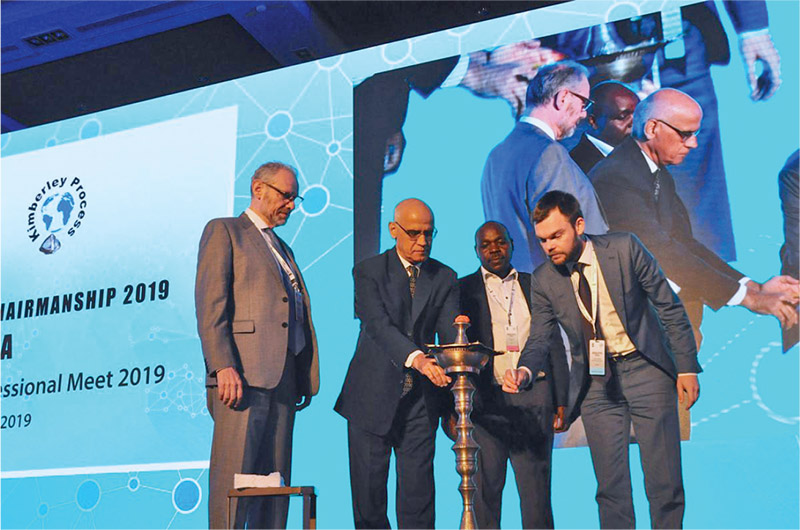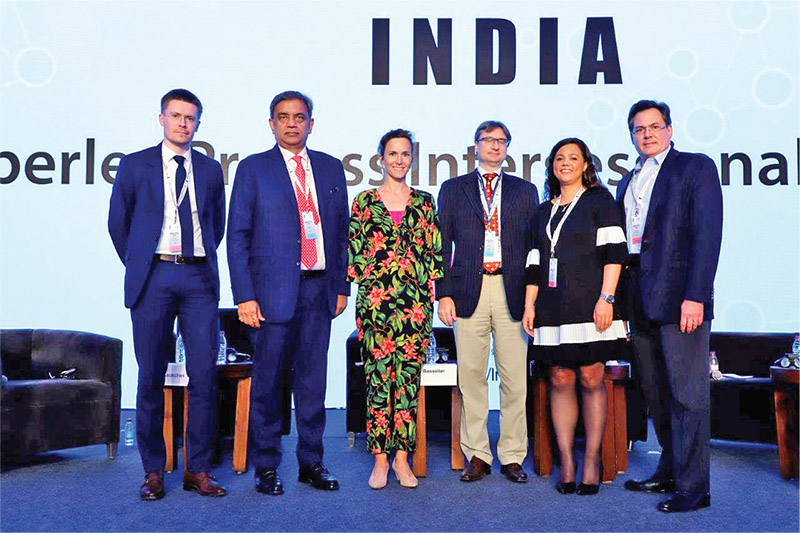India, as the Kimberley Process (KP) chair for 2019, successfully hosted the KP Intersessional meeting in Mumbai from June 17th to 21st.
The KP Intersessional, the annual mid-year event of the Kimberley Process Certification Scheme (KPCS), was organised by the union ministry of commerce & industry, Government of India, and co-organised by the Gem & Jewellery Export Promotion Council (GJEPC) in Mumbai.
The KPCS is a tripartite mechanism that unites participating governments, diamond industry and civil society. KPCS is an international mechanism mandated by United Nations (UN) to reduce the flow of conflict diamonds which were being used to finance wars against legitimate governments.
Alok Vardhan Chaturvedi, KP chair and director general of the Directorate General of Foreign Trade (DGFT), hosted and addressed over 200 KP delegates from 82 countries.
In his opening remarks, Chaturvedi noted that the international diamond industry has welcomed the adoption of the resolution by the United Nations General Assembly on March 1st, 2019, which calls for strengthening of KP to more effectively sever the link between illicit transaction of diamonds and conflict. He added, “India, as KP chair would continue to work with the governments, international diamond industry and civil society towards building consensus and strengthening KP. The KP Intersessional meet will help in creating a clear and concise Core Document, enhancing KP standards and modalities with peer review mechanism; raising the level of representation and participation; improving the gathering and flow of essential data amongst other key goals.”

Chaturvedi said that the international community has set in motion a historic plan to build a more prosperous, more equivalent and more secure world by 2030. The Government of India is strongly committed to the 2030 agenda, including the 17 Sustainable Development Goals (SDGs). He said that the philosophy of Sabka Saath, Sabka Vikas and Sabka Vishwas for inclusive development converges very well with the SDGs. He added that the KP has been a driving force for peace and prosperity, tying closely with the 2030 agenda.
Review and reform
During the five-day period, a range of issues were up for discussion, but dominating proceedings were the review and reform of the KPCS, and, in particular, the expansion of its scope.
New Delhi from November 11th to November 15th. Since decisions within the KP can only be reached with the full consensus of all government members, the discussions conducted during the Intersessional meeting and those that will take place in the remaining four and a half months are of critical importance.
In the speech he delivered to the opening session of the Intersessional, World Diamond Council (WDC) president Stephane Fischler drew a distinction between the concepts of review and reform. Review, he said, requires the improvement of the various instruments that the KP has created, so that the KPCS becomes more efficient and effective. The proposals on the agenda include a simplified and more consistent Core Document, a strengthened peer review mechanism, the creation of a permanent KP Secretariat to replace the Administrative Support Mechanism that currently exists, and the establishment of a MultiDonor Trust Fund (MDTF), which will assist financially-strapped nations to be fully involved in the KP and also support civil society in carrying out its duties.
Fischler pointed out that reform is a more transformative process. The diamond industry, he said, believes that this must involve expanding the scope of the “conflict diamonds” definition beyond goods that finance armed rebellion. “We strongly believe that, by helping eliminate the trade in diamonds directly associated with instances of systemic violence, we can bring about a more responsible and ethical mining sector, thus enabling a fairer distribution of the benefits delivered to millions of people,” he stated.
While WDC’s observer status in the KP does not afford it voting privileges, which are reserved exclusively for government members, along with fellow observer, the Civil Society Coalition, it formulated a proposal for an expanded “conflict diamonds” definition, which was formally tabled by the Government of Canada at the 2018 KP Plenary Meeting in Brussels last November. The expanded definition would now include stones “acquired through systemic and widespread violence, forced labour, the worst forms of child labour, or through violations of international humanitarian law.”
A separate proposal is now being awaited from the African Diamond Producers Association (ADPA), which is also a KP observer, and it is scheduled to be tabled following a meeting of African ministers that will take place in mid-July.
The review and reform process is being managed by the Ad Hoc Committee on Review and Reform (AHCRR), which was created at the KP Plenary Meeting in Brisbane, Australia, in 2017. It is chaired by Angola, with Canada serving as the vice chair. It includes a series of sub-committees, each of which is tackling a different element of the process, among them changes to the KPCS Core Document, the Peer Review Mechanism, the MDTF, and the establishment of the permanent KP Secretariat.
Chairing the Permanent KP Secretariat Sub-Committee is Peter Karakchiev, a WDC board member from Alrosa, the Russian diamond mining company. The Administrative Support Mechanism, which the prospective body will replace, has been funded and operated by WDC members on behalf of the KP since it was first established in 2013.
Members of the WDC team at the 2019 Intersessional meeting were closely involved in all meetings of the AHCRR, as well as its sub-committees. The subjects of review and reform were also discussed at length during a series of bilateral meetings held by the WDC with delegations from diamond producing countries, processing countries, consuming countries and fellow KP observers.
Preventing diamond-related conflict
In his speech, Shamiso Mtisi, coordinator of the KP Civil Society Coalition, commended the keen efforts of the EU chair to progress debate on the expansion of the KP’s scope, but hoped for consensus on adapting to the evolving nature of conflicts affecting diamonds.
The Civil Society Coalition went on to express its concern about certain interventions seemingly aimed at hampering the progress of talks. “It remains cynical that the KP claims to stop the flow of ‘conflict diamonds’ but continues to struggle in taking responsibility to define and monitor what conflict actually is”, said Mtisi. He pointed out that the current KP definition excludes diamonds that are the result of systematic violence, widespread abuse by public or private security services, torture and inhumane and degrading treatment. He emphasised that the KP had been entrusted with protecting the narrative of love and beauty that diamonds are intended to embody. Failure to address violence, he pointed out, would betray that mission.
The Civil Society Coalition called on all participants and observers to cooperate constructively in addressing the serious gaps in the current functioning of the Kimberley Process. Only in this way can we restore the image of diamonds and turn it into a driver of peace and development, Mtisi stated.
Optimising diamond resources
On June 17th, Stephane Fischler called on Kimberley Processmember governments to do what is necessary to safeguard the interests of their mining communities, and in so doing optimise the developmental potential of their natural resources.
“We must agree that the Kimberley Process should ensure that each government takes responsibility to ensure a chain of provenance, earning the trust of consumers wherever they are, and in so doing produce the revenues that must filter back to the grass roots of the mining communities,” Fischler stated.
Historically, he noted, one of the most critical factors determining whether a country’s economy is able to take advantage of the potential offered by its rough diamond deposits is the relative absence of ongoing conflict and violence.
“There is a dramatic disparity between the development level of those countries and the others that suffered the tragedy of civil war, Fischler stated. “Only today are some slowly realising the opportunities that their commodities could offer, in helping maintain the peace and allowing for nation building.”
“The Kimberley Process has today a one-time opportunity to make a difference in those countries where the diamond industry has not yet met its developmental potential,” he said. While the diamond industry and civil society will do all that they can to support constructive change as observers in the KP, ultimately it will be up to governments to reach consensus on the review and reform that is required, Fischler said.
“We need you, the country representatives, to have the courage to look into the eyes of your own people – the men, women and children active and living in the diamond-mining areas. They ask that they be allowed to live, rather than simply survive. They request safety and security for themselves and their families, and to be dignified with a proper wage, so that they may build a better future for themselves and their children, and contribute proudly as citizens,” he said. “We are relying on each of you, during this final year of the review and reform process, to show the consumers of diamonds that the Kimberley Process can unite around a programme that will ensure better care and protection of your brothers and sisters,” Fischler said.

Prior to the opening session, the WDC hosted an Observers’ Forum with the other official observers in the KP, including the Civil Society Coalition (CSC), the Diamond Development Initiative (DDI) and the African Diamond Producers Association (ADPA).
Strengthening KPCS
As the 2019 Intersessional meeting of the KP wrapped up on June 21st, Stephane Fischler expressed confidence that progress has been made in the effort to reach consensus on the review and reform of the KPCS. He called on participants to agree on the measures necessary for strengthening the KPCS’s impact, both in improving the lives and prospects of communities in the mining areas, and also in meeting the expectations of consumers in the jewellery markets.
“What is essential is that, together, we send a clear signal to the outside world, including consumers, that the KP remains a vitally relevant institution, which is able to evolve and adapt according to changing conditions. This must be the case at the upstream end of the chain of value, as it is at the downstream end,” he stated.
The WDC president pointed out the significant achievements the KP has achieved to date, including developmental programmes for artisanal miners that its members are currently involved in launching in places like Sierra Leone, Guinea, DRC and others, which would have been impossible, were it not for the role of the KPSC in returning peace to these areas.
Such developmental programmes, he said, are undermined when acts of violence bring the integrity of the diamond into question. “We will continue to stand on the front lines, highlighting our concerns and advancing and promoting solutions. To do that, we require the understanding, cooperation and support of all players in the chain of value. If we see consumers turning away, our market share shrinks, revenues fall, and all of us will feel the pain.”
The WDC’s eleven-person team at the KP Intersessional, led by Fischler and WDC executive director Marie-Chantal Kaninda, played key roles in various sessions of the plenary and working groups. On June 19th, Peter Karakchiev organised and moderated a Special Forum, which delved into the promotion of the Diamond Terminology Guidelines that were adopted as KP Best Practices last year. Most speakers in that forum were representatives of WDC member bodies. They included Karla Basselier, of the Antwerp World Diamond Center (AWDC);
The WDC members spoke about efforts being taken by the industry to bridge the expectations of stakeholders in the diamond producing countries and the growing demand by Millennial and Generation Z jewellery buyers that the products they buy have ethical and social value. “We cannot afford to have our competitors in the marketplace using the perceived shortcomings of the Kimberley Process to sell their own products,” said Bouffard during the Special Forum on diamond terminology. A second Special Forum on June 19th looked at grass-roots programmes being operated in diamond industry communities. The session on Artisanal Mining: Smaller Steps to Larger Outcomes was moderated by diamond industry analyst Pranay Narvekar. It featured, among others, Feriel Zerouki, of WDC member De Beers Group, who presented the GemFair initiative in Sierra Leone, which is working to formalise and support artisanal miners in the diamond value chain; and Sabyasachi Ray, executive director of the GJEPC, who outlined the Swasthya Ratna Policy, a heavily-subsidised health care plan created by the GJEPC for workers in the Indian jewellery sector and their families, which eventually could provide comprehensive coverage to more than 5 million people.
Narvekar said there were other shining examples of best practices followed across different sectors, which could offer potential solutions in the artisanal mining sector. The unorganised segments of the diamond pipeline could take a leaf from Mumbai’s Dabbawalas, who deliver and collect two lakh lunchboxes per day, with the help of 5,000 employees who use only local public transport and zero technology. The Mumbai Dabbawala Association has earned the coveted Six Sigma rating with an error rate of 1 in 6 million, stated spokesperson Ritesh Angre. Mahendra Patel of the All India Angadia Association elaborated on how Angadias or couriers offered logistic solutions to diamond dealers based purely on trust.
Addressing the Special Forum, Rupa Dutta, economic advisor, union ministry of commerce & industry, Government of India, outlined the importance of Common Facility Centres (CFCs) through the pooling of resources to improve the standard, quality and output of artisans, who have no exposure to technology. “These CFCs will ultimately empower small and medium units and help them become part of the larger organised sector,” she said.
In conclusion
In his closing remarks, Chaturvedi noted, “There has been a good exchange and ideas, discussions and deliberations, listening and learning, debates, dialogues in the true KP tradition of productive sharing of ideas to forge the way forward for KP. We are grateful to the global diamond community and the representatives of the Civil Society Coalition for their presence and active participation. The knowledge, experience and expertise that each one of you brings to the table is phenomenal and so is your collective effort. The commitment and contribution to usher in transformational change has been of the highest order.”
The KP session 2019 observed progress in many areas including deepening ongoing discussions on the scope, finalisation of Terms of Reference for Permanent Secretariat, draft Administrative Decision (AD) on Peer Review Mechanism, reconciliation guidance document and capturing of data for artisanal mining, new independent observer, clearer directions for the MDTF and consolidation of the Core Document. KP delegates will again meet in New Delhi for the Plenary Session in November 2019.
In his closing speech, the Fischler expressed confidence that the KP members will manage to find common ground and understanding in the process of reform. “This means that we all need to shift perspective, to ensure that the KP continues to deliver positive impact on the ground and also enhances the reputation of the diamond to consumers,” he said. He noted, “My fellow KP participants, as we prepare for the final five months of this reform and review period, let us pledge together that, in Delhi in November, we will emerge united and empowered.
“Let us ensure together that the diamond continues to hold its position as the world’s most popular gemstone, uniquely positioned as a symbol of love and commitment, and it remains a source of hope and promise for a better future, for people in all the countries in which it is produced – leaving no one behind.”

